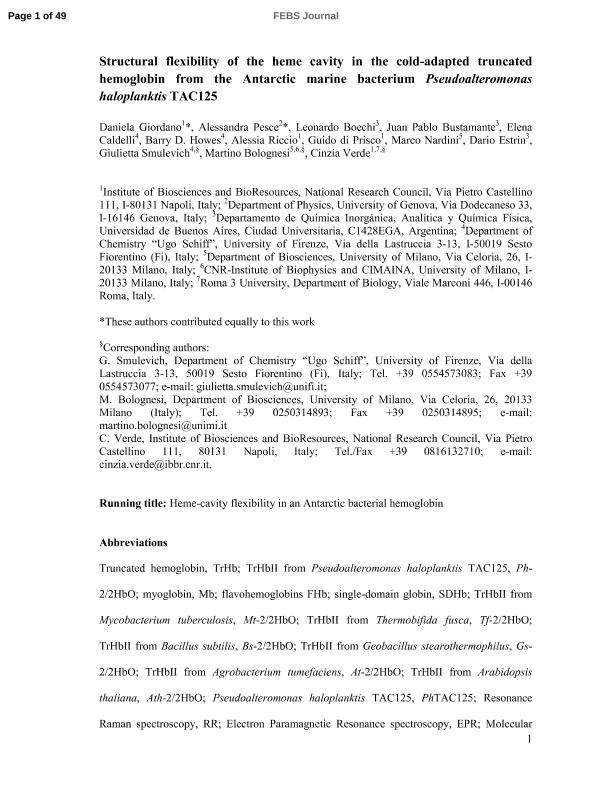Mostrar el registro sencillo del ítem
dc.contributor.author
Giordano, Daniela
dc.contributor.author
Pesce, Alessandra
dc.contributor.author
Boechi, Leonardo

dc.contributor.author
Bustamante, Juan Pablo

dc.contributor.author
Caldelli, Elena
dc.contributor.author
Howes, Barry D.
dc.contributor.author
Riccio, Alessia
dc.contributor.author
di Prisco, Guido
dc.contributor.author
Nardini, Marco
dc.contributor.author
Estrin, Dario Ariel

dc.contributor.author
Smulevich, Giulietta
dc.contributor.author
Bolognesi, Martino
dc.contributor.author
Verde, Cinzia
dc.date.available
2018-04-26T14:45:55Z
dc.date.issued
2015-08
dc.identifier.citation
Giordano, Daniela; Pesce, Alessandra; Boechi, Leonardo; Bustamante, Juan Pablo; Caldelli, Elena; et al.; Structural flexibility of the heme cavity in the cold-adapted truncated hemoglobin from the Antarctic marine bacterium Pseudoalteromonas haloplanktis TAC125; Wiley Blackwell Publishing, Inc; Febs Journal; 282; 15; 8-2015; 2948-2965
dc.identifier.issn
1742-464X
dc.identifier.uri
http://hdl.handle.net/11336/43534
dc.description.abstract
Truncated hemoglobins build one of the three branches of the globin protein superfamily. They display a characteristic two‐on‐two α‐helical sandwich fold and are clustered into three groups (I, II and III) based on distinct structural features. Truncated hemoglobins are present in eubacteria, cyanobacteria, protozoa and plants. Here we present a structural, spectroscopic and molecular dynamics characterization of a group‐II truncated hemoglobin, encoded by the PSHAa0030 gene from Pseudoalteromonas haloplanktis TAC125 (Ph‐2/2HbO), a cold‐adapted Antarctic marine bacterium hosting one flavohemoglobin and three distinct truncated hemoglobins. The Ph‐2/2HbO aquo‐met crystal structure (at 2.21 Å resolution) shows typical features of group‐II truncated hemoglobins, namely the two‐on‐two α‐helical sandwich fold, a helix Φ preceding the proximal helix F, and a heme distal‐site hydrogen‐bonded network that includes water molecules and several distal‐site residues, including His(58)CD1. Analysis of Ph‐2/2HbO by electron paramagnetic resonance, resonance Raman and electronic absorption spectra, under varied solution conditions, shows that Ph‐2/2HbO can access diverse heme ligation states. Among these, detection of a low‐spin heme hexa‐coordinated species suggests that residue Tyr(42)B10 can undergo large conformational changes in order to act as the sixth heme‐Fe ligand. Altogether, the results show that Ph‐2/2HbO maintains the general structural features of group‐II truncated hemoglobins but displays enhanced conformational flexibility in the proximity of the heme cavity, a property probably related to the functional challenges, such as low temperature, high O2 concentration and low kinetic energy of molecules, experienced by organisms living in the Antarctic environment.
dc.format
application/pdf
dc.language.iso
eng
dc.publisher
Wiley Blackwell Publishing, Inc

dc.rights
info:eu-repo/semantics/openAccess
dc.rights.uri
https://creativecommons.org/licenses/by-nc-sa/2.5/ar/
dc.subject
Haloplanktis
dc.subject
Extreme Environment
dc.subject
Hemeprotein
dc.subject.classification
Otras Ciencias Químicas

dc.subject.classification
Ciencias Químicas

dc.subject.classification
CIENCIAS NATURALES Y EXACTAS

dc.title
Structural flexibility of the heme cavity in the cold-adapted truncated hemoglobin from the Antarctic marine bacterium Pseudoalteromonas haloplanktis TAC125
dc.type
info:eu-repo/semantics/article
dc.type
info:ar-repo/semantics/artículo
dc.type
info:eu-repo/semantics/publishedVersion
dc.date.updated
2018-04-16T14:56:29Z
dc.identifier.eissn
1742-4658
dc.journal.volume
282
dc.journal.number
15
dc.journal.pagination
2948-2965
dc.journal.pais
Reino Unido

dc.journal.ciudad
Londres
dc.description.fil
Fil: Giordano, Daniela. Consiglio Nazionale delle Ricerche; Italia
dc.description.fil
Fil: Pesce, Alessandra. Università degli Studi di Genova; Italia
dc.description.fil
Fil: Boechi, Leonardo. Universidad de Buenos Aires. Facultad de Ciencias Exactas y Naturales; Argentina. Consejo Nacional de Investigaciones Científicas y Técnicas; Argentina
dc.description.fil
Fil: Bustamante, Juan Pablo. Universidad de Buenos Aires. Facultad de Ciencias Exactas y Naturales; Argentina. Consejo Nacional de Investigaciones Científicas y Técnicas; Argentina
dc.description.fil
Fil: Caldelli, Elena. Universita Degli Studi Di Firenze; Italia
dc.description.fil
Fil: Howes, Barry D.. Universita Degli Studi Di Firenze; Italia
dc.description.fil
Fil: Riccio, Alessia. Consiglio Nazionale delle Ricerche; Italia
dc.description.fil
Fil: di Prisco, Guido. Consiglio Nazionale delle Ricerche; Italia
dc.description.fil
Fil: Nardini, Marco. Università degli Studi di Milano; Italia
dc.description.fil
Fil: Estrin, Dario Ariel. Universidad de Buenos Aires. Facultad de Ciencias Exactas y Naturales; Argentina. Consejo Nacional de Investigaciones Científicas y Técnicas; Argentina
dc.description.fil
Fil: Smulevich, Giulietta. Universita Degli Studi Di Firenze; Italia
dc.description.fil
Fil: Bolognesi, Martino. Università degli Studi di Milano; Italia
dc.description.fil
Fil: Verde, Cinzia. Consiglio Nazionale delle Ricerche; Italia. Universita Di Roma; Italia
dc.journal.title
Febs Journal

dc.relation.alternativeid
info:eu-repo/semantics/altIdentifier/doi/https://doi.org/10.1111/febs.13335
dc.relation.alternativeid
info:eu-repo/semantics/altIdentifier/url/https://febs.onlinelibrary.wiley.com/doi/abs/10.1111/febs.13335
Archivos asociados
